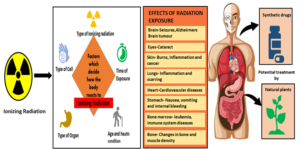 The root of radiation is nearly as ancient as the history of the creation of matter. Although the radiation emitted from the sun has been instrumental in the evolution of life on Earth, it has severe biological implications on the human body. Nature protects us from the harmful ionising radiation from outer space via the ozone layer. However, humans expose themselves to it on Earth because of planned or accidental exposures. We may include occupational hazards for employees of hospitals, uranium mines, nuclear power plants, and astronauts on space missions (cosmic radiation) in planned exposures.
The root of radiation is nearly as ancient as the history of the creation of matter. Although the radiation emitted from the sun has been instrumental in the evolution of life on Earth, it has severe biological implications on the human body. Nature protects us from the harmful ionising radiation from outer space via the ozone layer. However, humans expose themselves to it on Earth because of planned or accidental exposures. We may include occupational hazards for employees of hospitals, uranium mines, nuclear power plants, and astronauts on space missions (cosmic radiation) in planned exposures.
Exposure due to medical reasons may also be included in such cases, wherein the patients undergo an X-ray or a CT scan test, mainly during the radiotherapy for cancer patients. Accidental exposure includes leakage of radiation from unprotected radioactive material, unmonitored relative doses delivered to radiotherapy patients, and nuclear attacks like those at Hiroshima and Nagasaki during World War 2.
In any circumstance, the exposure to ionising radiation results in the genesis of reactive oxidative agents such as ROS (reactive oxygen species) and RNS (reactive nitrogen species). These free radicals, although short-lived, react rapidly with the cellular system of our body to achieve electron stability. The cell’s defence mechanism responds and manages to mitigate the damage caused from free radicals by releasing natural antioxidants in the body. However, the free radicals overcome the cellular defence and the resulting excessive oxidative stress generates an imbalance that the body fails to neutralise.
The effects of ionising radiation on the human body are both short-term and long-term. The short-term or acute effects comprise nausea, vomiting, fatigue and difficulty in breathing. The long-term or chronic effects include cataracts, skin cancer, brain tumors, myocardial infarction, hypertension, arthritis, immune and neurological disorders. Hence, it is postulated that a “radioprotective” agent with sufficient antioxidant and free radical scavenging ability can be used to stabilise the reactive species by providing them with an extra electron.
An ideal radioprotector must firstly offer easy and multiple ways of administration in our body. Also, it must protect most organs, be non-toxic, have long-term stability, and be compatible with other drugs prescribed to a patient. Sadly, the ideal radioprotector we are talking about is far from reality. So far, Amifostine is the only approved “synthetic” radioprotector. It was discovered as a potential candidate for radioprotection by the US Army Anti-Radiation Drug Development Program in 1959. But it should be noted that it has a high toxicity profile that causes various harmful side effects, which may deteriorate a patient’s health significantly. However, more recently, researchers have focused on other agents like immunomodulatory, stimulating agents, anti-inflammatory and adoptogens for their ability to repair the radiation-induced damage, in turn acting as radioprotectors. As of now, no concrete or promising development has been seen in this purview.
Generally, natural plants are perceived to be an efficient alternative to synthetic drugs. They have been effective in treating several ailments. They not only are safe but are also readily available. “Ayurveda”, the Indian traditional medicine system, is one of the most ancient that provides an abundance of knowledge based on literature like Vedas and Samhitas. The herbal plants and active chemical constituents isolated from them have shown the potential to minimise the DNA damage caused by radiation exposure. Because of this, the chances of cell survival increase drastically. Commonly known natural plants such as Tulsi, Amla, Brahmi, Pipli, Garlic, Capsicum, Jamun, Ashwagandha, Ginger, Aloe vera, Neem and many more have shown to protect against cellular damage caused due to radiation. The plants that exhibit radioprotective efficacy contain compounds that demonstrate antioxidants, immunostimulant, anti-inflammatory, adaptogenic and antimicrobial properties. Some of these compounds may work well single-handedly, while some may perform better in combination with other constituents from the same or different plants. However, there is a need for clinical testing of these medicinal plants and finding the exact mechanism for its implementation in routine treatment as an adjuvant to radiotherapy.
Author: Ms Sweta Kulkarni, PhD Research Scholar